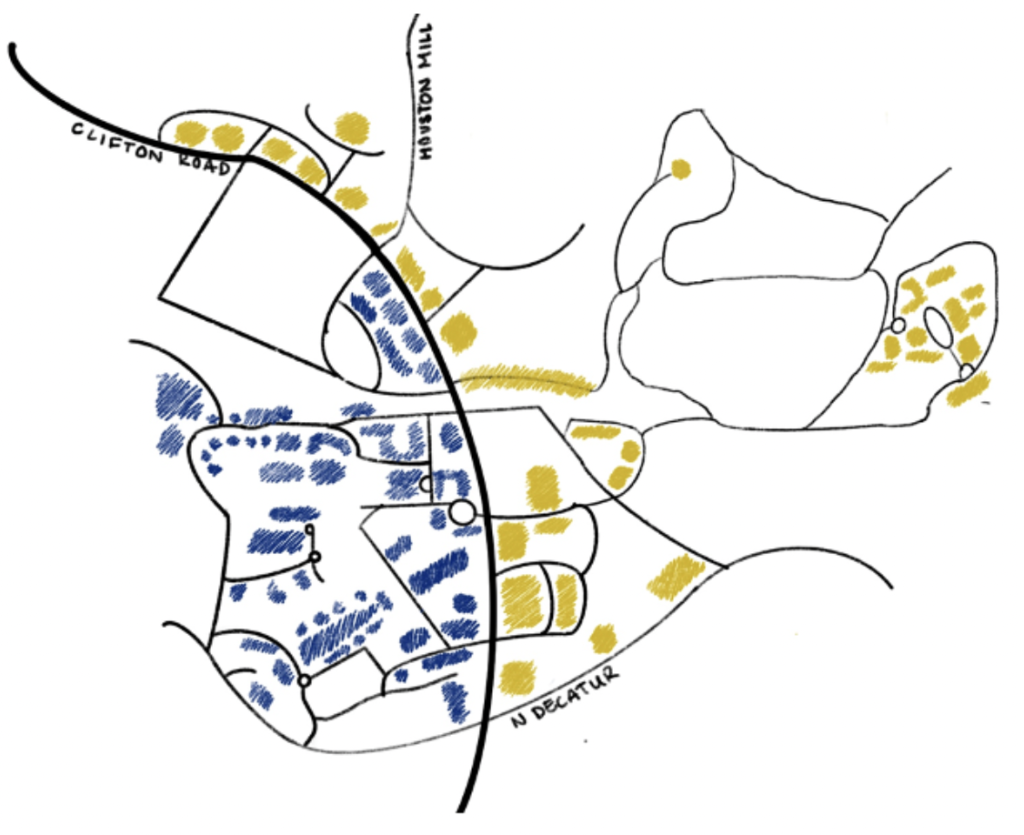Clifton Road is like the final straightway of a Grand Prix Circuit. Cars speed by vehicles stopped on the side of the road. Drivers swerve to avoid students and doctors who are late to their morning classes and appointments, rushing across Clifton on foot. Ambulances zoom to the emergency room, DoorDash drivers back up the ER drop-off zone and UPS trucks block traffic. The constant chaos of Clifton Road creates a hazardous maze that members of the Emory community must cross at their risk.
Clifton Road is in the middle of Emory’s Atlanta campus. While many vehicles use Clifton to commute to work at Emory, others have discovered that the newly straightened and divided Clifton is a quick conduit from Midtown Atlanta to Decatur. Clifton is a convenient shortcut, but the constant traffic and danger it poses to pedestrians detracts from Emory’s cohesion. Those who live on the east side of Clifton, such as at the Woodruff Residential Center, Clifton Towers or Emory Point, know this truth all too well. Clifton Road not only endangers students but also cultivates a divide between students who live on the west side of Clifton and students who live off campus or on the Clairmont campus.

Kira Eng / Contributing Illustrator
Emory launched a strategic framework known as “One Emory” in 2018. The framework seeks to promote a culture of engagement and cohesiveness across the Emory community via a number of initiatives, such as “Dining at the DCT,” which provides free meals between students and professors in the Dobbs Common Table dining room. In the pursuit of One Emory, the Emory administration has overlooked a key aspect of the physical infrastructure of campus that makes it impossible to achieve a cohesive community. The chaos of Clifton Road restricts access to the Robert W. Woodruff Library, Asbury Circle, many academic spaces and most on-campus dining for students who live on the east side of Clifton. Many critical institutions, such as upperclassmen housing, the School of Law and the Emory Hatchery, are stranded on the east side of Clifton, separating upperclassmen and graduate students from campus. This isolation runs counter to the vision of One Emory.
Most upperclassmen live within a one-mile radius of campus, with 40% on Clairmont Campus and many others at Emory Point, Clairmont Reserve and Decatur Highlands. My walk to campus would be about one mile — but I’ve never done it. Many of my friends who live at Emory Point or off North Decatur Road have an even shorter walk but choose to Uber or drive because of the danger and inconvenience of Clifton Road. Additionally, 60% of Emory Law students drive to class, and 60% also live in the neighborhoods directly adjacent to Emory in Druid Hills or North Druid Hills, according to a housing guide provided by Emory Law School. Yet, once students get to campus, they go to class, maybe hang out to study for a few hours and then head home. Julia Goldman (23B) drives to campus if she has to return for an evening activity because she doesn’t want to walk on Clifton in the dark. If she did not have a car, she said she would be deterred from going to evening events like KEGS at the Goizueta Business School. The danger of traveling to and from campus discourages students from returning later to participate in campus activities.
For example, anyone who has ever taken a right from Clifton Road onto Houston Mill Road has seen the confusing situation that drivers and pedestrians must navigate due to the strange angles of the crosswalks and impossibly narrow sidewalks. Just the other day, I was driving home and almost ran over a student’s dog that had wandered slightly off the tiny sidewalk as he and his owner were waiting to cross. Every successful navigation of this fraught intersection feels like a victory. Sure, students can walk on the other side of the road and avoid this particular disaster zone, but where would they cross? And how long might they have to wait?
The Clifton and Houston Mill intersection isn’t an exception — it’s the rule. All along Clifton Road, crosswalks are poorly spaced, and walk lights often don’t respond to push buttons. Clifton’s curves create poor lines of sight, and drivers go too fast to see the pedestrians simply trying to get to class on time.
“I am again waiting a ridiculously long time to cross west across Clifton Road,” said Allison Burdette, Professor in the Practice of Business Law, about standing at the Clifton and N Decatur Road intersection. Burdette served as part of the inspiration for this article and assisted with its beginning, citing her experience with Clifton Road and what should be done to remedy the issue. “Cars are speeding by, thwarting my scheme to make a mad dash for it. I mutter a complaint under my breath, and a student responds, ‘Further evidence of Emory succumbing to the primacy of the car culture.’”
The dangers and frustrations of crossing Clifton Road mean that Emory employees and students almost always drive to campus if they have access to a car. Yes, Emory provides shuttles, but the timing is inconsistent and shuttles often fill up quickly. Driving is faster, easier and safer — but it shouldn’t be. It shouldn’t be easier and safer to get into a two-ton metal contraption, especially when Emory is trying to reduce its carbon footprint.
Beyond student safety and environmental sustainability, Emory should consider that the Clifton Road speedway is also a poor first impression for visiting families and prospective students. They may be staying at the Emory Conference Center, in which case they are forced to navigate the crossing onto the main campus themselves, or they might drive in — where their first impression of Emory is the bridge across Clifton connecting the hospitals. They see the traffic jam that is the cars trying to get into the ER, cars randomly pulling over to let passengers out and a large expanse of concrete. The entrance to Lullwater is isolated, unassuming and uninviting: a disservice to one of the coolest features of Emory’s campus. Getting to Lullwater is another story altogether. The Haygood Drive NE and Clifton Road intersection lacks a crosswalk on the north side, encouraging students to jaywalk.
As Emory tries to lure excellent students to Atlanta, one of the goals of One Emory, the University needs to consider the demands of prospective students and their parents and focus not just on beautifying the academic spaces but enhancing all aspects of campus.
Unfortunately, many of Emory’s campus improvements over the past decade have been antithetical to making Emory more pedestrian friendly. Too often, the solution from Emory Development has involved widening the sidewalks and then saying, “All done!” An example of this misguided solution by the Emory Planning Office is the 2016 “improvements” to Clifton Road. Emory widened the road and aimed to make Clifton “more efficient,” creating a faster conduit for cars and a more dangerous situation for pedestrians. Recently, Emory widened the sidewalks alongside the new public health building, the R. Randall Rollins Building, but wider sidewalks help with pedestrian safety only while pedestrians are walking on them. They do nothing to end the tyranny of the speeding cars on Clifton Road or to help the pedestrians get from one side to the other.
Other U.S. universities have also had to address significant thoroughfares bisecting their campuses. For example, the University of Tennessee similarly has its law school and dormitories on the north side of a major thoroughfare, Cumberland Avenue. While a pedestrian bridge crosses this road at vital student crossing points, Cumberland Avenue has been narrowed to one lane with pull-offs for Lyfts and deliveries, crossing islands in the road and crosswalk buttons that work. Illinois Wesleyan University, Kent State University (Ohio) and Purdue University (Ind.), to name a few, have also moved to embrace pedestrians in their campus infrastructure improvements.
To further the goals of One Emory, the University should narrow Clifton Road, adding pull-offs for deliveries and pick-ups as well as protected bike lanes. Secondly, Emory should set stoplights to favor pedestrians over cars, adding sensors to control lights during non-rush hour times. Rerouting hospital traffic behind the hospital would prevent back-ups on Clifton. Additionally, pedestrian crossing islands would enhance safety if students cross between crosswalks. The Clifton and Haygood Drive NE intersection should be restructured, with new lines and added curbs to protect bikers.

Kira Eng / Contributing Illustrator
Let’s use our voices to ask Emory to put students before cars. Emory administration, just think: with a little tender loving care and a few cans of paint, you could improve accessibility and safety, enhance student life and create a more cohesive campus, living up to Emory’s strategic goal: One Emory.
Kira Eng (23B) is from Seattle, Washington.
Professor in the Practice Allison Burdette assisted with this article.





